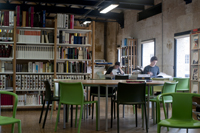| Titre : | Vito Acconci | | Type de document : | texte imprimé | | Auteurs : | Frazer Ward, Auteur ; Mark C. Taylor (1945-....), Auteur ; Jennifer Bloomer (1951-....), Auteur | | Editeur : | London : Phaidon | | Année de publication : | 2002 | | Importance : | 160 p. | | Présentation : | ill. en noir et en coul. | | Format : | 29 cm | | ISBN/ISSN/EAN : | 0-7148-4002-5 | | Note générale : | Bibliogr. p. 159-160 | | Langues : | Anglais (eng) | | Mots-clés : | performance vidéo art architecture expérimentale | | Index. décimale : | MON Monographie | | Résumé : | Vito Acconci.
American artist Vito Acconci is recognized for his daring and revolutionary contribution to the course of late twentieth century art. A key pioneer of performance and video art in the late 1960s, Acconci has continued to surprise his audience by working in new and unexpected media, blurring disciplines from sculpture to installation to architecture. All of his work involves an investigation into the boundary between the body and public space, often with an implied social message. Initially a poet, Acconci turned to visual arts in 1969, gaining the attention of art audiences with such early performances as his notorious Seedbed (1972), when the artist masturbated beneath a ramp covering the gallery floor, his fantasies about the viewers he could hear but not see amplified in the gallery above.
The artist reached a turning point in 1974 when he decided no longer to place his own body within his artworks. He continued investigating his chosen social themes with sculptures and installations, such as Instant House (1980), in which the viewer can create a private space in the midst of a public exhibition. Since the mid 1980s Acconci's work has turned towards experimental design and architectural projects, among them his Storefront Renovation for the Storefront for Art and Architecture, New York (1993). Acconci has been included in many seminal group exhibitions of postwar art history, among them 'Information' (The Museum of Modern Art, New York, 1970), and Documentas 5 and 7 (1972 and 1982).
The work of Acconci Studio was also featured at the Venice Architecture Biennale (2001). Art critic Frazer Ward chronicles the key moments in Acconci's thirty-year career, selecting emblematic works which illustrate the different media in which the artist has worked. In the interview artist discusses with theorist Mark C Taylor his concern for the human body as a social, spatial and linguistic entity.
In the Focus, architectural theorist Jennifer Bloomer analyzes one of the artist's recent architectural works, World in Your Bones (1998). For his Artist's Choice, the artist has selected Alain Robbe-Grillet's screenplay for Alain Resnais' film Last Year at Marienbad (1961). Noted also for his poetry and theoretical essays, the selection of Artist's Writings spans his early experimental poetry from the late 1960s to a cultural analysis of public art and architecture in the 1980s and 1990s. |
Vito Acconci [texte imprimé] / Frazer Ward, Auteur ; Mark C. Taylor (1945-....), Auteur ; Jennifer Bloomer (1951-....), Auteur . - London : Phaidon, 2002 . - 160 p. : ill. en noir et en coul. ; 29 cm. ISBN : 0-7148-4002-5 Bibliogr. p. 159-160 Langues : Anglais ( eng) | Mots-clés : | performance vidéo art architecture expérimentale | | Index. décimale : | MON Monographie | | Résumé : | Vito Acconci.
American artist Vito Acconci is recognized for his daring and revolutionary contribution to the course of late twentieth century art. A key pioneer of performance and video art in the late 1960s, Acconci has continued to surprise his audience by working in new and unexpected media, blurring disciplines from sculpture to installation to architecture. All of his work involves an investigation into the boundary between the body and public space, often with an implied social message. Initially a poet, Acconci turned to visual arts in 1969, gaining the attention of art audiences with such early performances as his notorious Seedbed (1972), when the artist masturbated beneath a ramp covering the gallery floor, his fantasies about the viewers he could hear but not see amplified in the gallery above.
The artist reached a turning point in 1974 when he decided no longer to place his own body within his artworks. He continued investigating his chosen social themes with sculptures and installations, such as Instant House (1980), in which the viewer can create a private space in the midst of a public exhibition. Since the mid 1980s Acconci's work has turned towards experimental design and architectural projects, among them his Storefront Renovation for the Storefront for Art and Architecture, New York (1993). Acconci has been included in many seminal group exhibitions of postwar art history, among them 'Information' (The Museum of Modern Art, New York, 1970), and Documentas 5 and 7 (1972 and 1982).
The work of Acconci Studio was also featured at the Venice Architecture Biennale (2001). Art critic Frazer Ward chronicles the key moments in Acconci's thirty-year career, selecting emblematic works which illustrate the different media in which the artist has worked. In the interview artist discusses with theorist Mark C Taylor his concern for the human body as a social, spatial and linguistic entity.
In the Focus, architectural theorist Jennifer Bloomer analyzes one of the artist's recent architectural works, World in Your Bones (1998). For his Artist's Choice, the artist has selected Alain Robbe-Grillet's screenplay for Alain Resnais' film Last Year at Marienbad (1961). Noted also for his poetry and theoretical essays, the selection of Artist's Writings spans his early experimental poetry from the late 1960s to a cultural analysis of public art and architecture in the 1980s and 1990s. |
|  |


 Ajouter le résultat dans votre panier Affiner la recherche
Ajouter le résultat dans votre panier Affiner la rechercheVito Acconci / Frazer Ward


